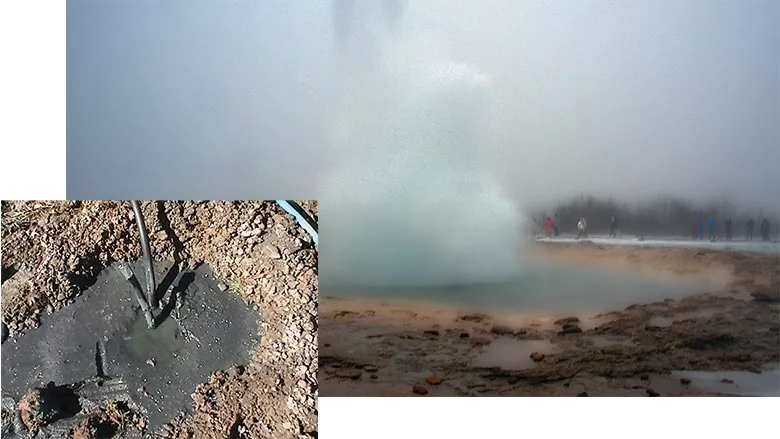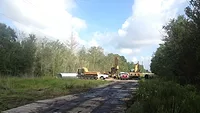Geothermal Identity Crisis: Clarifying How We Scale to Meet Decarbonization Goals

Photo: lower-left courtesy Brock Yordy; center courtesy Edward Palm / Getty Images
Since the passing of the Inflation Reduction Act in 2022, the most significant question regarding the success of the United States in meeting 2030 to 2050 carbon reduction goals is how we scale. Every report released proposes the same questions for capacity, and the industry continues to echo these questions.
“What project locations are feasible to scale?” “How can we increase engineering capacity?” “Where will the capital investment come from to scale?” “Can our aged infrastructure handle new capacity?” “Who will step up and build the technology required to scale?”
Ironically, these questions apply to both High-Temperature and Low-Temperature geothermal systems. While the geothermal industry races to meet decarbonization goals, consumers are also confused about scale. When geothermal energy is discussed, the scale in their minds tries to understand how drilling for power generation involves drilling boreholes to heat and cool their homes.
Adopting geothermal energy is further complicated by the local, state, and federal parties involved. It starts with the perception of infrastructure deployment and what the end consumers will receive. The next issue concerns the capital investment required to complete a project. The final identity crisis issue is the necessary oversight and regulation to ensure High Temp doesn’t create a super volcano and low temp doesn’t impact or contaminate groundwater aquifers. However, amidst these challenges, the potential of both types of geothermal energy adoption shines brightly, offering hope for a sustainable future.
Let's drill deeper into why society is confused and why the industry fails to address the low-temperature versus high-temperature elephant in the room. The National Renewable Energy Laboratory (NREL) in a presentation titled Historical Pattern Analysis of Global Geothermal Power Capacity Development: by Ediger, Volkan Ş. and Sertaç Akar. Stated, “The United States has the world's highest installed geothermal power capacity and proven geothermal resource potential. The US introduced the first wide-scale geothermal power generation in 1961 at the Geysers Geothermal Field in California. However, John Grant started the Geyser geothermal system forty years earlier, in 1921; he used the power generation of the first well to drill multiple more wells. Upon completion, the initial system generates 250 kilowatts of energy to light buildings and streets in the surrounding area. Sadly, this is the first evidence that fossil fuels are a cheaper solution right now than harnessing the earth's energy with less greenhouse gas production in the future. Today, the Geyser system generates 1.5 Gigawatts for California. To put that into perspective, 1.5 GW is enough for one million homes and about 40% of all power generated by steam geothermal energy.
Perhaps the industry identity crisis starts with California and Texas, two states holding the most house seats in Congress representing geothermal from a power generation standpoint. Or maybe it is that throughout many technical papers, the process starts with drilling a “geothermal well.” Even the most recent September 26, 2024, ASME article titled Ingenuity Turned the Geysers into a Powerhouse on the history of geothermal steam power generation links a podcast on geothermal drilling for ground source heat pumps.
The Department of Energy has strongly tried to educate the industry and public on the differences between geothermal from “hot rock” to ground source loops. At several ground source geothermal conferences this year, Alexis McKittrick, program manager for the Geothermal Technologies Office (GTO), broke down how the DoE offices separate the different geothermal types. The GTO states that low-temperature geothermal resources are systems below 300 degrees Fahrenheit, including geothermal heat pumps and district heating systems. Also, direct-use geothermal energy falls into low-temperature systems that hit less than 300 degrees. High temperatures of geothermal typically start beyond 300 degrees, such as steam, flash steam, Enhanced Geothermal Systems (EGS), and power generation. Again, to add to the confusion of high versus low, it is easy to find technical papers discussing power generation systems at 260 degrees, below the 300-degree separation.
Innovators worked towards ground source heat pump systems within the same timeline as Grant and harnessing steam power generation. Notably in 1948, Carl Nielsen, a professor at Ohio State University, built the first open loop ground source heat pump. However, we all know the true “OSU” to champion ground-source geothermal heat pumps comes two decades later and will be located in Oklahoma. In 1999, the Clinton administration started the initiative of geothermal heat pumps for federal buildings. The 1999 Office of Geothermal Technologies Titled Geothermal Heat Pumps for Federal Buildings report stated, “Today, GHPs are becoming a widespread technology, and not just among Federal agencies. There are over 400,000 GHPs in service in the United States. According to the EPA, residential GHP systems are the most energy-efficient, environmentally clean, and cost-effective space conditioning systems available in each country. Furthermore, when evaluating total energy loads for commercial building systems, including compressor and related fan and pump costs, GHP systems require less power/ton than conventional systems.”
Geothermal Heat Pump systems in 1999 had exceptional representation from the White House and DoE with a strong emphasis on geothermal heat pumps. Another primary consideration from twenty-five years ago was the simplicity of installation, which helped promote acceptance and adoption.
Twentieth-century ground source geothermal heat pump systems highlighted the construction of 100 to 400-foot boreholes. The industry should be challenged to develop technical papers outlining the simplicity of bore field design and the subsequent speed of deployment that comes with that simplicity. High-temperature geothermal requires deep wells with compounding complexities and increased risk. The possibility of encountering volatile gas at 1000 feet is more significant than at 500 feet. However, drilling from 1000 to 8000 feet will penetrate confining layers, relieving pressure in the form of gas or liquid. Oil and Gas drilling companies are required to prepare for high-risk situations associated with drilling greater depths. The perception of drilling companies failing to prevent a catastrophic failure in geothermal is very high to the general public. Much like what was released in 1999, there must be education to the general public and regulators that shallow geothermal drilling of boreholes for heat pumps does not present the same possibilities for failure.
However, the industries’ identity crisis of deep and shallow geothermal drilling is further exacerbated by select shallow drilling operators touting oil and gas drilling techniques and management as the only way to be successful. Adopting the best drilling technology for the drilling project and conditions is crucial. Yet, it is also essential for shallow geothermal drilling to have its image outside of oil and gas exploration. Suppose it looks like it could be a fracking operation and sounds like a fracking operation. In that case, the general contractor is empowered to put a giant white sheet on the bore field fence saying, “I assure you we are not fracking,” written in black shoe polish.
In the final quarter of 2024, with just five years and two months to hit our 2030 goals, the mistaken identity of construction for power generation geothermal is something that our industry can work through. Even though there are several differences, the goals both industries are working towards cannot happen without wide-scale success of both High Temperature and Low Temperature. The ultimate goal of ground-source heat pumps is to relieve stress on the power grid. Next, eliminate the use of fossil fuels for heating, which requires electrification. The goal of geothermal power generation is to provide fossil fuel-free energy. We can’t have one without the other. The true identity crisis lies within heat pumps and the less complex installation of air source systems versus drilling to install geothermal heat pump systems.
Geothermal, by any other name, is what we need to meet our DeCarbonization Goals.
Looking for a reprint of this article?
From high-res PDFs to custom plaques, order your copy today!





